
views
Selecting a Location
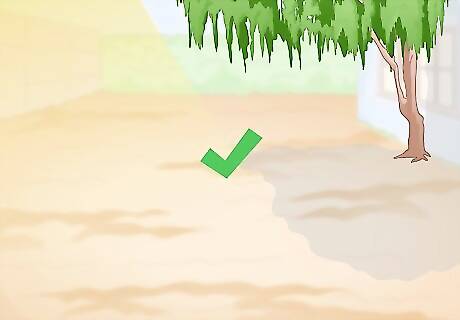
Pick a spot with both sunlight and shade. Plan on building the pond in a location that is about 70% covered by shade. A good place to build a pond is partially underneath the shade of a tree. Sunlight keeps the pond warm while shade prevents the frogs and their water from drying out. Build underneath a deciduous plant like an oak and maple trees. The tree will lose its leaves in the fall so the pond receives full sunlight in the winter, preventing it from freezing.
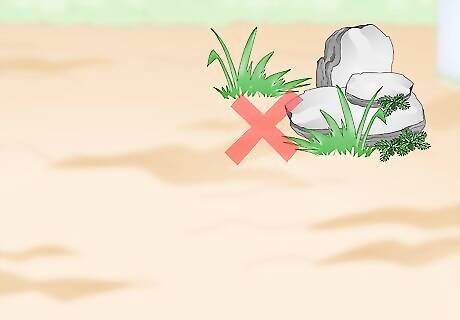
Choose flat land clear of rocks and grass. Frog ponds are relatively flat so the frogs are able to get in and out of the water. Once you have an ideal spot, dig up any stones you see. Remove plants by digging underneath their roots to lift them out of the soil. If you need to dig up sod, cut it into strips with a spade, then roll it up to clear the ground. The flatter the land is, the better it will be for your pond. If it isn’t flat, consider digging out the high points and filling in the low points. Avoid placing the pond near slopes, since water and debris will seep into it.
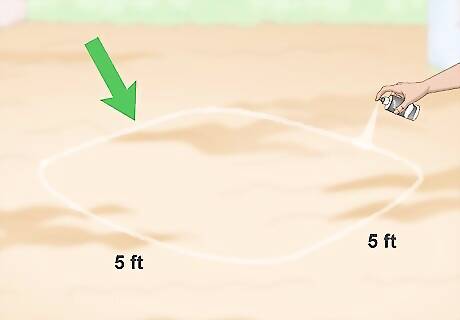
Measure the space you have available for your pond. Sketch an outline on the soil with some marking spray paint. An average pond is about 5 ft (1.5 m) long and 5 ft (1.5 m) wide. Bigger ponds provide more shelter for the frogs and are better if you have space for them. Most constructed frog ponds are oval or crescent-shaped. Adjust the shape of your pond as needed to fit it in the space you have available, but try to keep a basic shape so the pond liner fits it easily.
Constructing the Pond
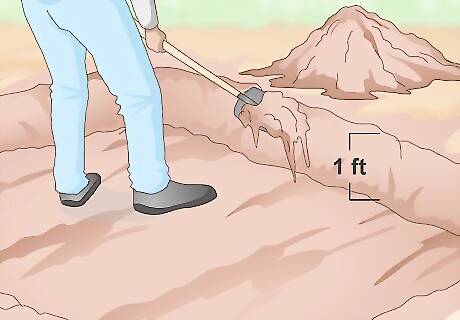
Dig out the soil until the pond is at least 1 ft (0.30 m) deep. Remove the soil, setting it aside away from the pond’s edges. Make sure the pond reaches its maximum depth in the center. The pond does not need to be deep in order to be a good habitat for frogs. Make the pond no more than 3 ft (0.91 m) deep. This depth is enough for frogs in colder climates to safely hibernate during the winter.
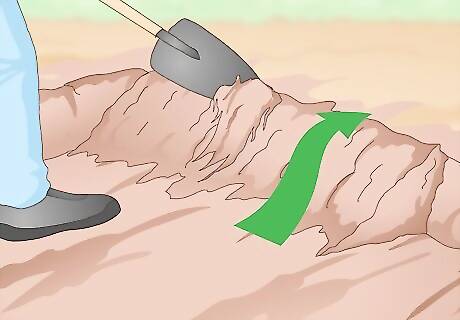
Pack dirt into the pond to create a gentle slope up to the sides. The pond needs to slope gradually so frogs have no trouble climbing out of the water. Start putting the soil back around the edges of the pond. Keep filling the pond to create a very gentle incline towards the center, which will be the deepest point. Make a 10% grade or smaller incline. As long as the pond’s slopes gently without any ridges around the perimeter, it will be safe for frogs.
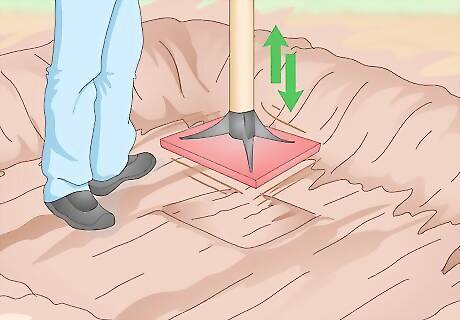
Press the soil down with a tamper tool to flatten it. A tamper tool is a square-shaped tool that you press down against the soil to compact it. Go over the entire pond until the soil is firmly in place. The tamper will also press rocks into the soil so their rough edges can’t slice up the pond liner. Tamper tools are available at most hardware stores. You may be able to rent one there as well.
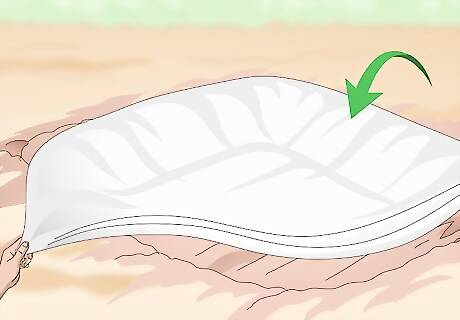
Fill the pond with a protective underlay to prevent damage to the liner. Select an underlay that is big enough to cover your entire pond. Center the underlay in the hole you dug, draping it over the pond’s edges. Press down against the underlay, smoothing it out to eliminate wrinkles and air bubbles. Underlays are made of a soft material like polypropylene. They are extra useful if you have rocky soil or have pets and wild animals that may visit the pond. If you have high-clay soil or wetland soil, you may be able to skip using a pond liner and underlay. The pond will fill with water on its own.

Fit an EPDM or PVC pond liner over the underlay. Choose a pond liner that is big enough to cover your pond. Fit it in place the same way you did with the underlay. Make sure it covers the entire underlay, then flatten it out to remove wrinkles and air pockets that could lead to damage later. If you wish to remove the excess liner and underlay, cut it with scissors or a utility knife. Leave them a little long so they overhang the pond walls. Removing the excess is optional since you can always cover it with rocks and plants. Another option is to get a rigid plastic liner from a home improvement store. This type of liner is like a tub which you set in the ground. You do not need an underlay beneath it. Alternatively, you can have a concrete pond. It is a pond that does not give you any problems. You can waterproof the pond. You don't have to worry about the liner getting a hole. It is the ultimate pond structure you can get. But most people don't have a budget to do a full plumbing system in the concrete, rebar, and structural components that take up or make up the cost of the concrete structure for a pond. So if you have the money, build a concrete pond.
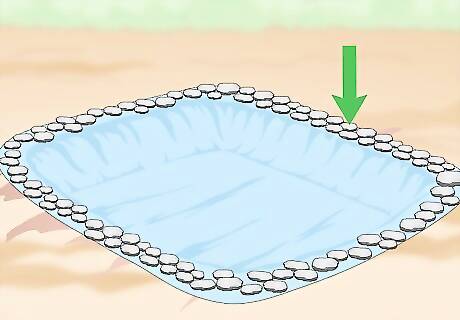
Place heavy rocks around the pond to hold the liner in place. Get several big landscaping rocks and fit them inside the pond. Rest them against the edges of the soil. These stones cover up the liner and provide some hiding spots for tadpoles. To make the rocks look more natural, choose stones that do not look uniform. Position them all differently instead of laying them horizontally in a ring. Check landscaping companies and nearby home improvement stores for stones. You may be able to find some in the wild, but don’t take them unless you have permission to do so.
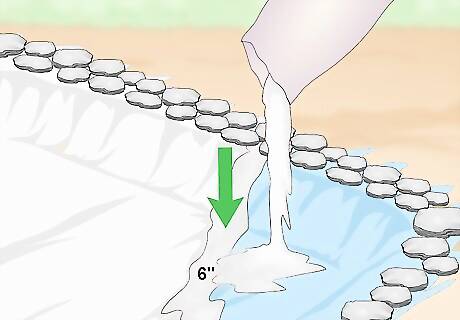
Cover the pond liner with about 6 in (15 cm) of gravel. Purchase a few bags of pond gravel, set them in your pond, and cut them open. Spread the rocks around to create an even bottom layer hiding the pond liner from view. The rocks also serve as a cushion to protect the liner from damage. Sand and dirt also work but make the pond look dirty. Try mixing some gravel in with play sand or topsoil to create a more effective bottom layer.
Decorating and Filling the Pond
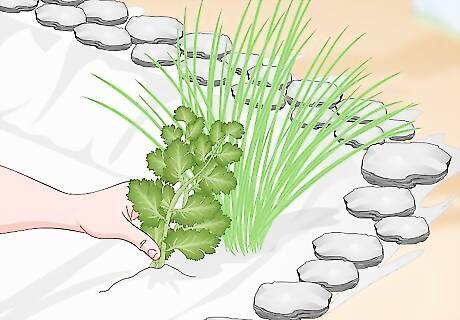
Place plants in the pond to provide shelter for the frogs. Pick out some plants that grow naturally in your area. Bushy, leafy plants are ideal since they both provide cover and attract insects frogs love to eat. Take the plants out of their pots and install them directly in the sand or gravel at the bottom of the pond. Scatter them around so they give your pond a more natural aesthetic. Some good plants for the deeper parts of the pond include pennywort, water celery, Mexican starflower, tassel sedge, and marsh flowers. For the shallower parts of the pond, choose plants like sedges, water canna, rush, nardoo, lemon bacopa, and arrowhead.
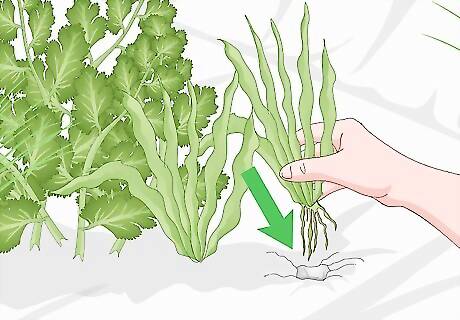
Include filter plants to keep the pond clean and oxygenated. Put the filter plants in the pond along with the other plants. A few plants to try include anacharis, water hyacinths, tapegrass, and water lilies. Free-floating plants like hornwort also help, but fill the pond with water before adding them. Frog ponds aren’t usually equipped with a filter. If your pond is large, consider installing a pump and filter system. Pumps can be dangerous to tadpoles, so rely on plants if possible.
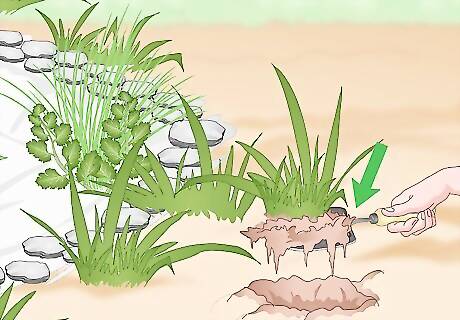
Grow grass and other plants for shelter around the pond. Moisture-loving plants create shade while also making your pond look more natural. Dig up the soil beyond the pool liner and put the plants in place. Some plants to grow include maidenhair ferns, violets, bottlebrush, coral pea, and deer grass. Cover the roots up with a mound of soil or some wood-based mulch. Slice away the excess pool liner as needed to fit the plants near the water’s edge. Be careful not to cut the liner down too far. Let it extend past the pond’s edges by at least 2 in (5.1 cm). Fill in the gaps between plants with gravel, stones, and soil to hide an exposed pool liner.
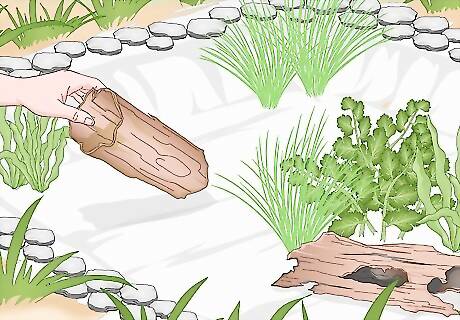
Add logs to the pool to give it more texture. Frogs, especially vulnerable tadpoles, enjoy having places to hide. Improve your pond by getting a piece of driftwood, for instance, and setting it near a pond wall. Make sure it’s stuck firmly in place near some water plants. If you don’t have a good piece of driftwood, try piling dirt to create mounds close to the edges of the pond. The mounds make the pond look more natural while also giving the frogs a little bit of hiding space.
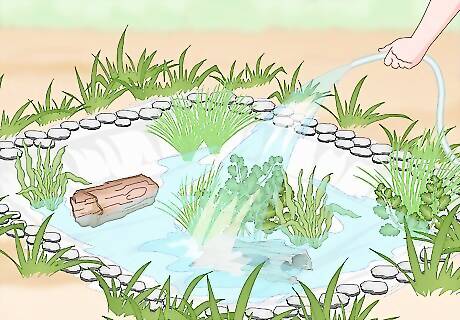
Use a hose to fill the pond to the top with water. Run a garden hose from a nearby spigot to the pond. Your pond needs between 18 to 24 in (46 to 61 cm) of warm water. Make sure the pond stays filled, especially during warmer months. Fill the pond as needed to keep the water level consistent. Let the pond fill with rainwater, if possible. Rainwater has less harmful chemicals than tap water and doesn’t need to be treated. Tadpoles hatch in late spring and grow throughout the summer. This is the most important season for maintaining the pond’s water level.
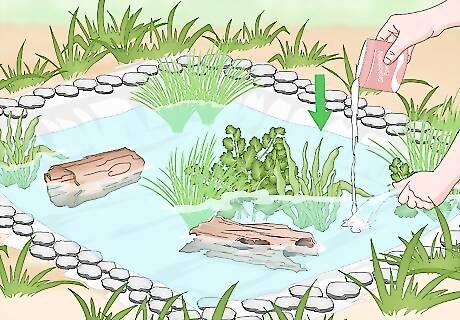
Dechlorinate the water with a chemical treatment and a hose. Purchase a jug of dechlorinating powder, then sprinkle it into the water according to the manufacturer’s instructions. To mix in the powder, turn on your hose and spray the pond’s surface. Chlorine is toxic to frogs, so you won’t see any at your pond unless you dechlorinate the water first. Any time you need to add tap water to the pond, add some of the powder.

















Comments
0 comment